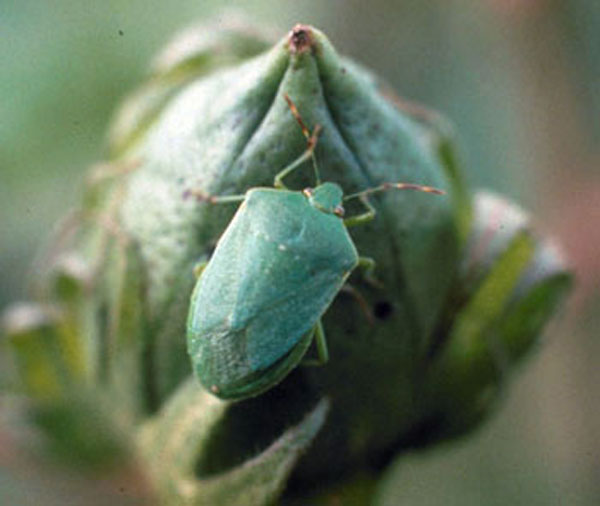November 18, 2013

Information from North Carolina’s licensed independent crop consultants is invaluable in determining cotton pest status and insecticide inputs from region to region and from one year to the next.
Their responses to our survey questionnaire are both an accurate account of the past “insect year” and represent approximately one third of North Carolina’s total cotton acreage.
The following observations are based on the 2013 and other recent surveys of this group.
Thrips still a pain: Although stink bugs ranked slightly ahead of thrips in damage this past year based on the 2013 survey, essentially all producers in North Carolina use treated seed and most (more than 85 percent of our consulted acreage this year) applied an additional follow-up foliar spray — making thrips control an expensive proposition compared with the control costs required for stink bugs and other cotton pests.
Imidacloprid (Admire Pro, and generics) applied as a liquid, in-furrow spray onto treated seed (if applied with precision) appears to offer producers their best present hope of a “one-and-done” at-planting option that might minimize the need for a subsequent foliar spray. We will post another blog on this option in the coming week.
Stink bug damage
Stink bug damage a concern: As is often the case in wetter years, stink bug levels and damage in 2013 were quite a bit higher that in the previous 6 years, receiving this year’s No. 1 pest ranking by our consultants.
Check current cotton futures prices
Based on our project’s fall boll damage survey of 211 grower-managed cotton fields, stink bug damage to bolls averaged 6.5 percent, compared with an average of 3.4 percent over the previous 6 years. Fortunately, because stink bug damage often spares some boll locks, stink bug damage to bolls is typically scored approximately 40 percent of that of a bollworm-damaged boll in the yield loss category.
Plant bugs on the rise?: The consultants’ survey unveiled some interesting insights about plant bug damage, showing both a significant possible trend towards higher treatment levels in recent years and confirming sharp regional differences in population levels as indicated by treated acreage.
In the 2005-2007 period, consultants’ clients sprayed 5.3 and 6.8 percent of their cotton acreage for plant bugs pre- and post-bloom, respectively.
In the 2011-2013 period, this figure was 19.8 and 45.2 percent, respectively, for the pre- and post-bloom period.
Plant bug levels have certainly appeared to have trended upward in recent years, with 6 of our 24 consultants (primarily in our far eastern counties), having 100 percent of their clients’ acreage treated for plant bugs in 2013 — with some fields requiring 2-4 applications.
On the other hand, 6 other consultants representing our north-central and southern acreage, recommended treatment on an average of 2.8 percent of their clients’ acres this year.
The above survey information shows the value of scouting- and threshold-based spray decisions as opposed to a one-size-fits-all, autopilot, calendar-based approach. The latter approach typically falls under the category of revenge, recreational or default treatments — not a recipe for profit.
Where did the bollworms go?
What happened to bollworms?: Bollworm damage to bolls was lower in 2013 than in any year of my damaged boll survey — which began in 1985. Certainly, 2 gene Bt cotton has helped significantly in lowering bollworm and other caterpillar damage.
Bollworms emerge initially from the soil as moths in the spring (most often in May). They subsequently undergo 2 generations, the first on whorl stage corn (and other hosts) and the next generation on silking stage corn.
For all generations, an underground pupal stage is necessary. As we determined in the mid-1970s, pupal cell integrity is important in the survival of this stage.
One might guess that a high proportion of pupal cells were destroyed in many areas of the state due to our extended rainy weather and saturated soil conditions.
All the consultants surveyed indicated stink bugs were the primary driver of late-season applications in 2013, with bollworms a non-issue for most. This was the first year I recall that so many light traps reported zero moths during consecutive days during our “major” bollworm moth flight.
Cotton aphids and spider mites: Consultant surveys, calls and our own observations indicated that we got a break from other insect pests in 2013, with 3.4 and 1.4 percent of consultants’ clients’ acreage being sprayed for spider mites and cotton aphids, respectively.
Cotton aphid colonies were few and far between, while the moderate level of spider mites calls and reports often revealed populations that did not reach treatable levels, probably in part a result of our generally high rainfall and humidity in 2013.
Insect pest predictions for 2014: In trying to predict what producers can expect in the way of insect pests in 2014, for soybeans it’s easy: More kudzu bugs.
Based on many years of experience, for cotton two points come to mind:
• We don’t have a clue about 2014.
• The expense of scouting- and threshold- based decisions pays for itself many times over.
You May Also Like




